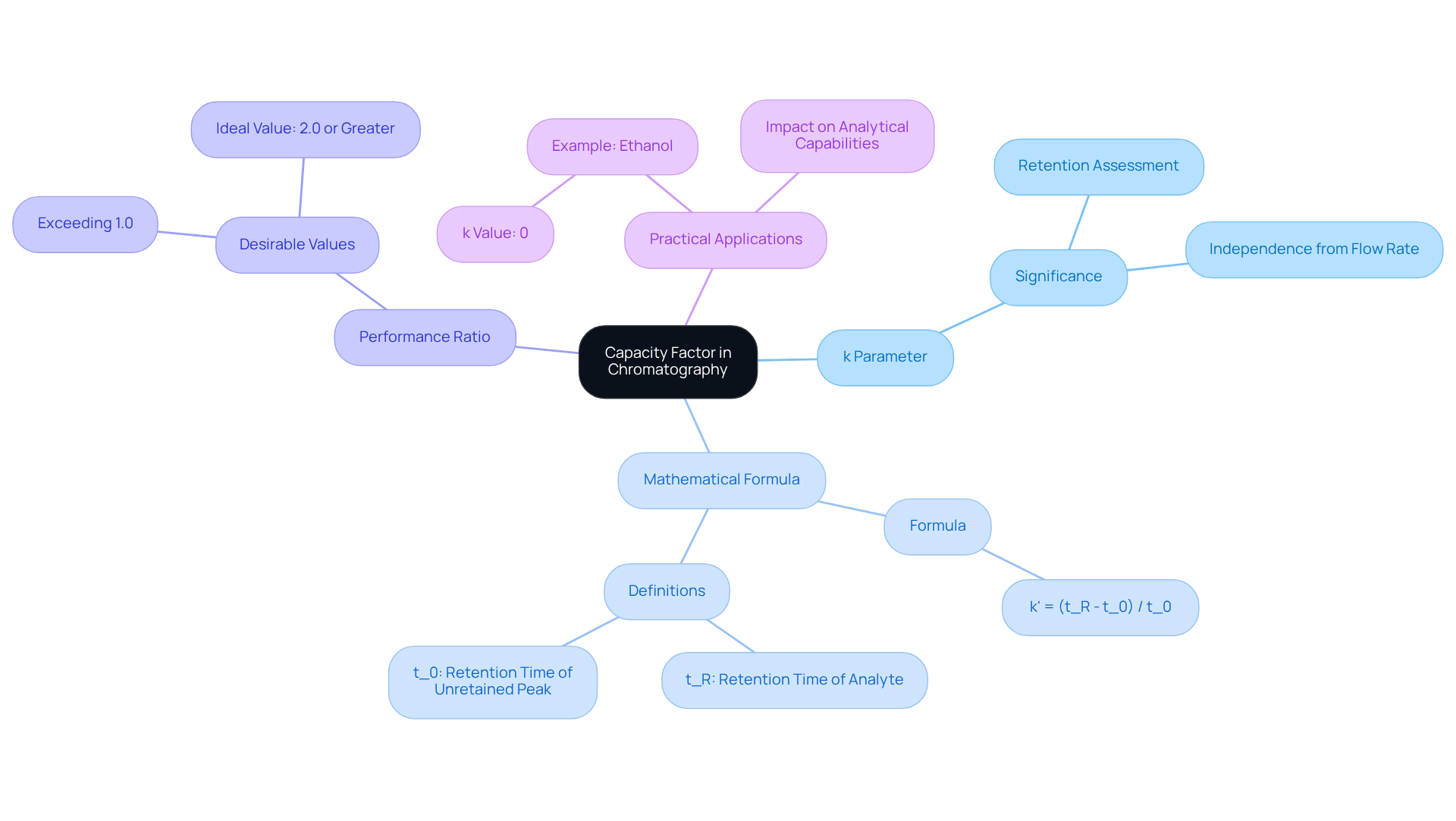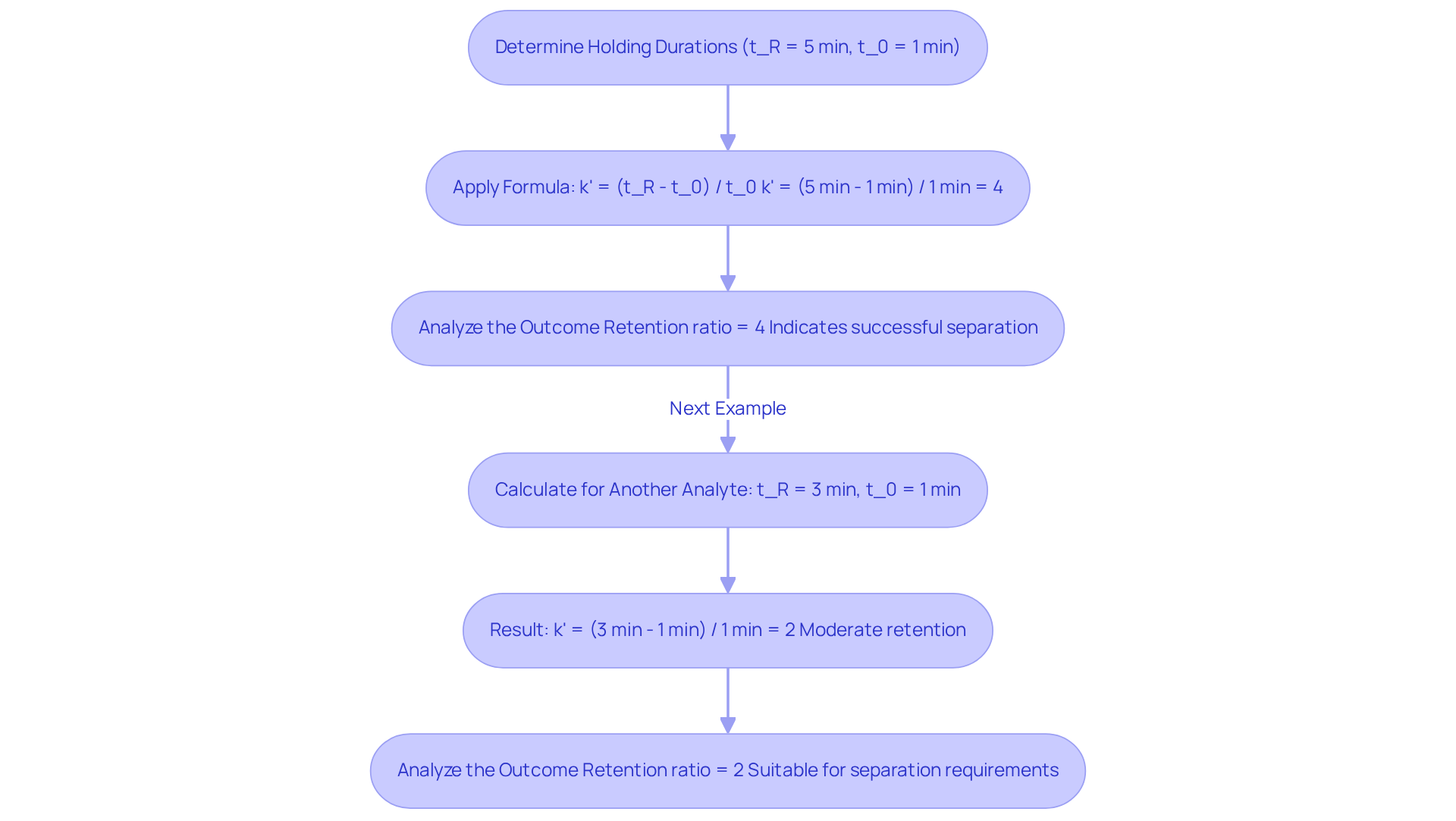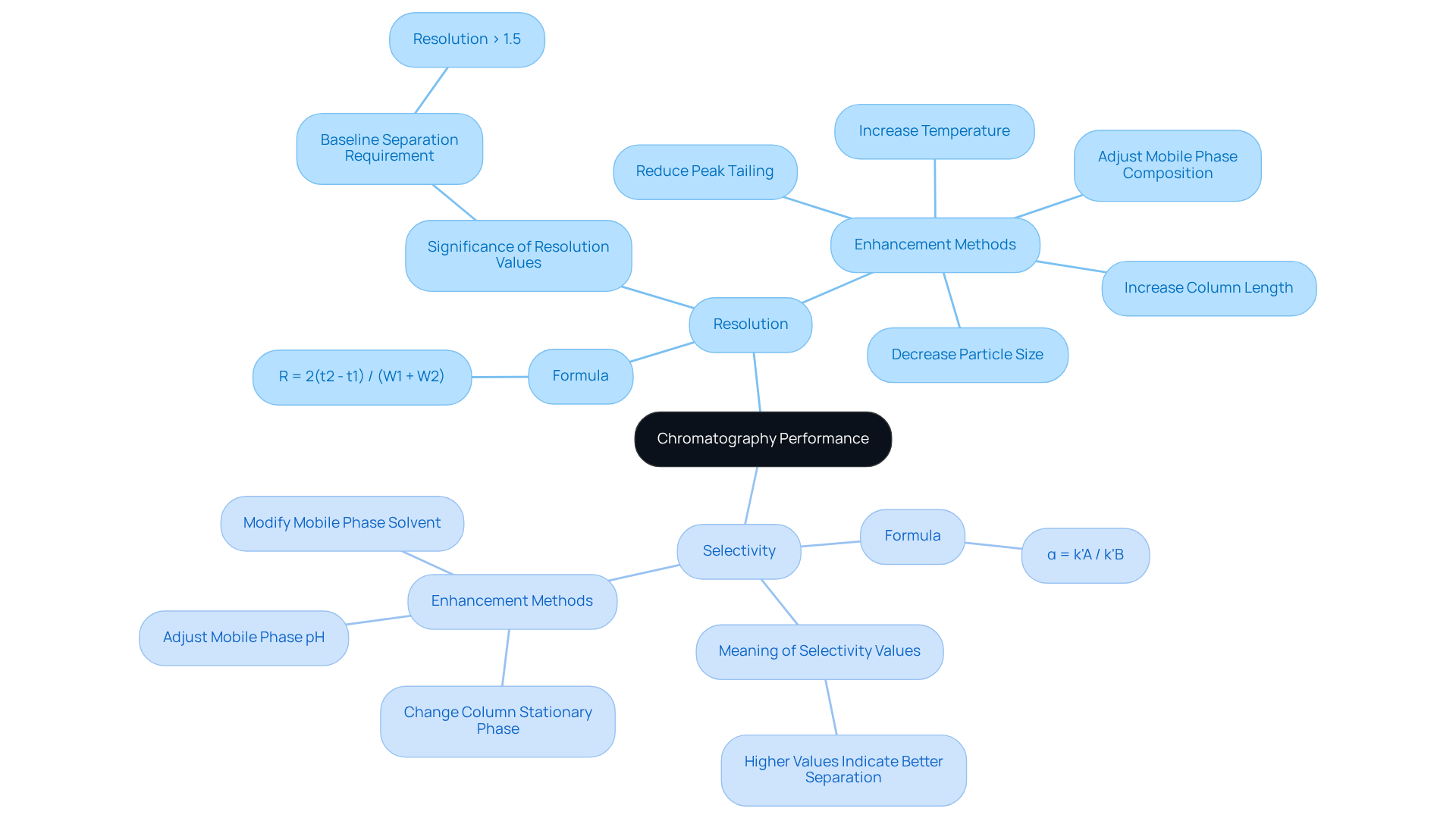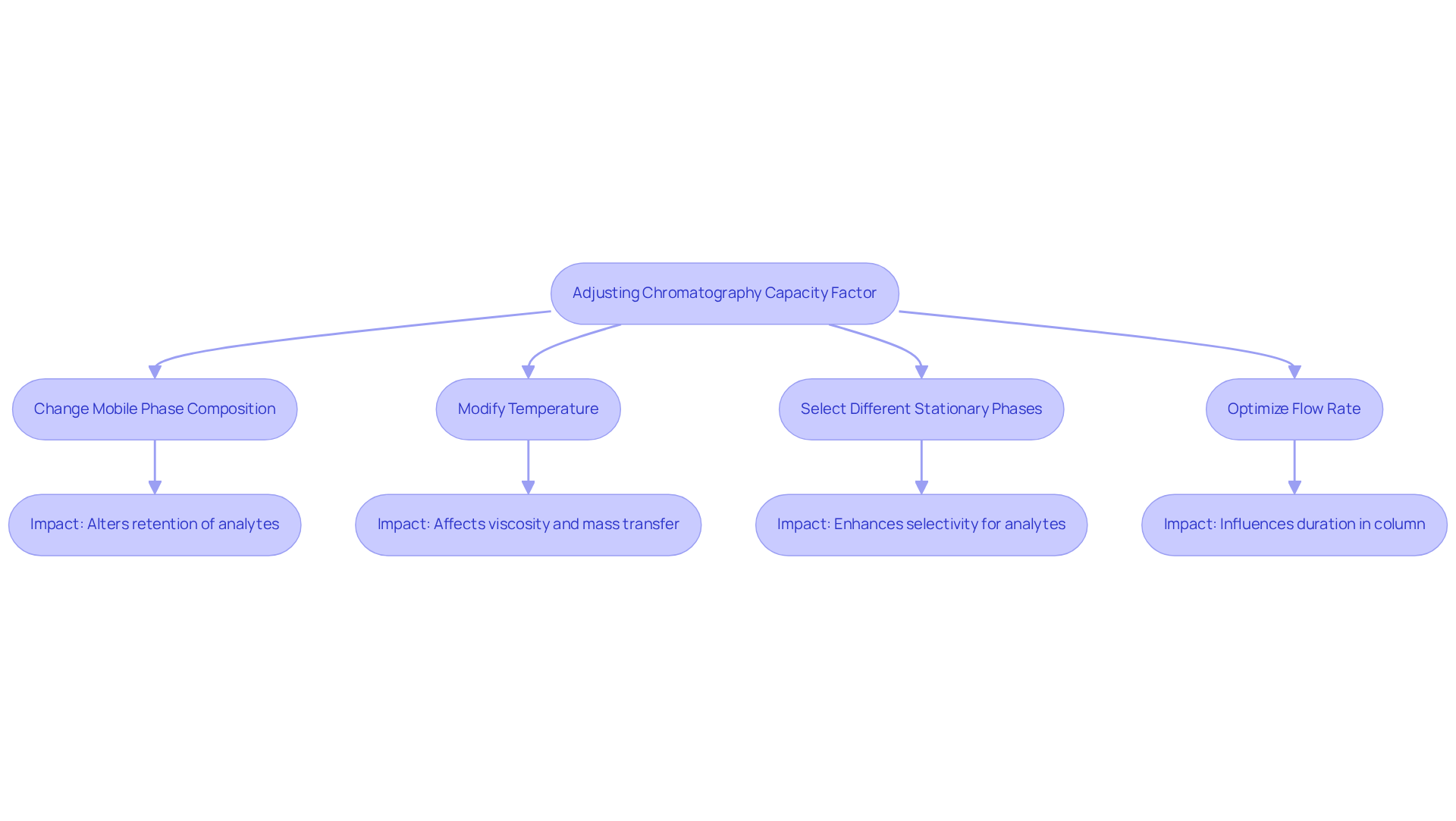Overview
The chromatography capacity factor, denoted as k', plays a pivotal role in evaluating the retention of an analyte on the stationary phase in comparison to the mobile phase. Higher k' values signify enhanced separation efficiency, a crucial aspect of chromatographic analyses. Mastering this factor is essential; techniques such as adjusting the mobile phase composition, temperature, and flow rate can significantly improve the resolution and selectivity of chromatographic methods. This mastery ultimately translates to more accurate laboratory results, reinforcing the necessity for precision in scientific instrumentation.
Introduction
Understanding the nuances of chromatography is essential for any laboratory striving for precise analytical results. Central to this process is the capacity factor, a critical metric that significantly influences the retention of analytes and the overall efficiency of separations. As laboratories pursue improved accuracy and reliability, one pivotal question arises: how can mastering the capacity factor transform chromatographic practices and elevate analytical outcomes? This article delves into key techniques and best practices for optimizing the chromatography capacity factor, offering insights that can profoundly enhance laboratory performance.
Define Capacity Factor in Chromatography
The k parameter, known as k prime, is a pivotal element in the chromatography capacity factor, which assesses the retention of an analyte on the stationary phase relative to the mobile phase. This relationship is mathematically represented as:
k' = (t_R - t_0) / t_0
where t_R denotes the retention time of the analyte and t_0 signifies the retention time of an unretained peak, commonly referred to as the void time.
A higher performance ratio indicates stronger retention of the analyte, which is critical for achieving effective separations in chromatographic processes. Notably, this performance ratio remains independent of flow rate, allowing for comparisons across diverse chromatographic conditions. Understanding the chromatography capacity factor is essential for optimizing chromatographic methods, as it directly impacts the accuracy and reliability of laboratory analyses. In practical applications, a performance ratio exceeding 1.0 is desirable, with an ideal value of 2.0 or greater, as emphasized by Uwe D. Neue: "The ideal is 2 or better." This ensures that the earliest eluting peak of interest is sufficiently resolved.
Moreover, it is vital to acknowledge that ethanol possesses a value of 0, indicating no retention on the stationary phase, thereby illustrating the concept of retention in chromatography. By mastering the performance ratio, laboratories can significantly enhance their analytical capabilities and improve the quality of their results.

Calculate the Capacity Factor: Formula and Examples
Determining the chromatography capacity factor is crucial for understanding the performance ratio of analyte hold in chromatography. To effectively grasp this concept, consider the following step-by-step guide:
- Determine the holding durations: For instance, an analyte may exhibit a holding duration (t_R) of 5 minutes alongside a void duration (t_0) of 1 minute.
- Apply the formula:
k' = (t_R - t_0) / t_0
k' = (5 min - 1 min) / 1 min = 4 - Analyze the outcome: A retention ratio of 4 signifies that the analyte is retained four times longer in the stationary phase compared to the mobile phase, indicating successful separation.
Example 2: Consider another analyte with a retention time of 3 minutes and a void time of 1 minute:
k' = (3 min - 1 min) / 1 min = 2
This result indicates moderate retention, which may be suitable depending on the separation requirements.
In pharmaceutical laboratories, performance metrics for common analytes can vary significantly. For example, a ratio of approximately 2 is frequently observed for numerous pharmaceutical compounds, indicating a balance between holding and elution efficiency. The FDA recommends a performance ratio exceeding 2 to ensure effective separation in chromatographic techniques. Understanding these calculations is essential for optimizing chromatographic methods, especially in terms of the chromatography capacity factor, thereby ensuring precise and reliable results in analytical applications. It is also noteworthy that the performance ratio was historically referred to as the preservation ratio, emphasizing its background in chromatography. Additionally, factors such as flow rate can greatly influence retention times, making it imperative to consider these variables when analyzing chromatographic data.

Analyze the Impact of Capacity Factor on Resolution and Selectivity
The performance metric is paramount in establishing both resolution and selectivity in chromatography.
Resolution (R) is defined as the ability to separate two peaks in a chromatogram. It is influenced by the performance ratio, where higher k values typically yield improved separation. This relationship can be articulated as:
R = 2(t2 - t1) / (W1 + W2)
Here, t1 and t2 denote the retention times of the two analytes, while W1 and W2 represent their respective peak widths. A resolution value exceeding 1.5 is generally necessary for baseline separation, underscoring the significance of narrow, well-separated peaks for optimal chromatographic performance.
Selectivity (α) pertains to the ability to distinguish between different analytes. It is determined by the ratio of capacity factors for two peaks:
α = k'A / k'B
where k'A and k'B denote the capacity factors for analytes A and B, respectively. Elevated selectivity values signify better separation between peaks, which is crucial for accurate analysis.
By modifying the performance ratio through adjustments in mobile phase composition or temperature, both resolution and selectivity can be enhanced, leading to more efficient separations. For instance, employing a less strong mobile phase allows solutes to linger longer in the stationary phase, resulting in extended elution times and improved retention values. Such adjustments are vital for achieving high-quality chromatographic results, especially when analyzing complex mixtures.
Case studies have illustrated that optimizing the performance metric not only bolsters resolution but also amplifies the overall efficacy of chromatographic separations. Grasping these relationships is essential for developing robust HPLC methods that satisfy the stringent demands of pharmaceutical analysis.

Adjust Capacity Factor: Techniques and Best Practices
Adjusting the chromatography capacity factor can be achieved through several effective techniques.
Change the Mobile Phase Composition: Altering the solvent strength or pH can significantly impact the retention of analytes. For instance, utilizing a less potent solvent can improve the performance ratio for specific compounds, thereby enhancing their separation efficiency. The ideal HPLC system identified for various analyses utilized a mobile phase with 35% acetonitrile, which is crucial for attaining the desired performance ratios.
Modify the Temperature: Increasing the temperature can reduce viscosity and enhance mass transfer, potentially lowering the chromatography capacity factor. Conversely, lowering the temperature of the column can lead to longer durations, facilitating improved separation of analytes. Research has demonstrated that temperature modifications can greatly affect holding durations and overall chromatographic performance.
Select Different Stationary Phases: Different stationary phases interact variably with analytes, affecting their retention. Choosing a phase with greater selectivity for your analytes can significantly enhance performance metrics, resulting in more accurate outcomes. For example, the quantity of theoretical plates was determined to be 5,044.42 in specific analyses, indicating good column efficiency and separation of piperine, which is essential for enhancing performance measures.
Optimize Flow Rate: Modifying the flow rate impacts the duration analytes remain in the column, thereby influencing the chromatography capacity factor. Typically, reduced flow rates prolong the intervals, facilitating improved separation. The flow rate for HPLC analysis was set between 0.8-1.2 mL/min, underscoring the importance of this parameter in achieving optimal results.
Best Practices:
- Regularly calibrate your instruments to ensure accurate retention time measurements, which is vital for reliable results. As noted in various studies, calibration is essential for maintaining method accuracy.
- Document all modifications made to the method and their impacts on performance metrics to enhance your technique over time and improve reproducibility. This practice is crucial for understanding the effect of adjustments on chromatographic outcomes.
- Utilize software applications for method development that can replicate the effects of various parameters on performance metrics, aiding in the optimization process. Such tools can provide valuable insights into the relationships between variables.
- Ensure that the chromatography capacity factor remains within acceptable limits, typically between 2 and 8, to maintain effective separation and analysis.

Conclusion
Mastering the chromatography capacity factor is essential for enhancing analytical performance in laboratory settings. This critical parameter, represented as k prime, provides insight into the retention of analytes on the stationary phase versus the mobile phase. By understanding and applying the capacity factor, laboratories can achieve more effective separations, leading to improved accuracy and reliability in their analyses.
The article delves into the definition and calculation of the capacity factor, emphasizing the importance of achieving a performance ratio greater than 2 for optimal results. It highlights the relationship between the capacity factor and key chromatographic concepts such as resolution and selectivity, demonstrating how adjustments in mobile phase composition, temperature, and flow rate can significantly impact these metrics. Practical examples and best practices are provided to guide laboratories in optimizing their chromatographic methods.
Ultimately, understanding and effectively managing the chromatography capacity factor is crucial for laboratories aiming to enhance their analytical capabilities. By implementing the techniques discussed, such as modifying mobile phase conditions and optimizing flow rates, professionals can achieve superior separation and analysis of complex mixtures. Embracing these practices not only elevates the quality of results but also underscores the significance of the capacity factor in advancing chromatographic science.




